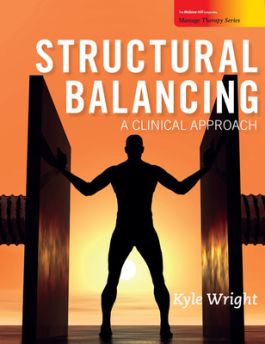Structural Balancing: A Clinical Approach
1st Edition
0073373923
·
9780073373928
© 2011 | Published: January 19, 2010
Structural Balance: A Clinical Approach by Kyle Wright advances the reader’s clinical knowledge and hands-on skills of trigger point therapy techniques, postural and body structural conditions that cause chronic pain and discomfort, and specific th…
Read More
Receive via shipping:
- Colour, print bound version of the complete text
Preface
Forward
Welcome Chapter-Value of Soft Tissue Therapy
Section I: Foundations
Chapter 1: Components of Structure: Bones and Landmarks
Chapter 2: Structural Analysis and Postural Assessment
Chapter 3: Muscle Tension and Causes
Chapter 4: Symptoms and Conditions of Muscle Tension
Chapter 5: Principles of Reversing Muscle Tension
Section II: Clinical Massage Therapy and Structural Bodywork
Chapter 6: Posterior Lower Extremity Compartment (PLEC)
Chapter 7: Anterior Torso Compartment (ATC)
Chapter 8: Anterior Lower Extremity Compartment (ALEC)
Chapter 9: Posterior Torso Compartment (PTC)
Chapter 10: Upper Extremity Compartment (UEC)
Appendix A-Muscles of the Body
Appendix B-Receptor Tonus Principles and Neuro-Physiological Laws
Appendix C-Agonists, Synergist, and Antagonist
Appendix D-Chiropractic and Massage: Symbiotic Health Care-Dr. Kelly Huber
Appendix E- Mind - Body Connection- Robert J. Rotella, Ph.D.
Appendix F- Proper Stages of Rehabilitation of Injured Soft Tissues
References and Resources
Credits
Glossary
Muscle Index
Index
Structural Balance: A Clinical Approach by Kyle Wright advances the reader’s clinical knowledge and hands-on skills of trigger point therapy techniques, postural and body structural conditions that cause chronic pain and discomfort, and specific therapies and exercises for resolving those conditions. Appropriate for clinical courses in massage therapy, physical therapy, and chiropractic programs, this text provides a step-by-step illustrated guide of manipulations for easy learning of muscle pains and their causes. Content is practical and treatment specific, discussing muscle attachments, pain patterns, clinical notes, range-of-motion exercises, physical distortions, and proper positioning. Structural Balance teaches employable skills for a variety of healthcare specialties.

